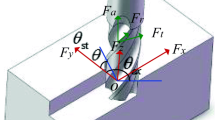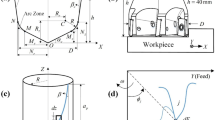Abstract
Extracting discriminative tool wear features is of great importance for tool wear monitoring in micro-milling. However, due to the dependency on tool runout and cutting parameters, the traditional tool wear features are incompetent to monitor the tool wear condition in micro-milling with significant tool runout and varied cutting parameter interactions. In this study, micro-milling cutting force is represented by a parametric model including variable cutting parameters, tool runout, and tool wear. The cutting force coefficient in the model, which is not only discriminative to the tool wear condition but also independent to the tool runout and cutting parameters, is extracted as the micro-milling tool wear feature. To reduce the computation cost, a fast neural network–based method is proposed to identify the tool runout and the cutting force coefficient from the cutting force signal. Experimental results show that the proposed cutting force coefficient–based approach is efficient to monitor the micro-milling tool wear under varied cutting parameters and tool runout.









Similar content being viewed by others
References
Câmara MA, Campos Rubio JC, Abrão AM, Davim JP (2012) State of the art on micromilling of materials, a review. J Mater Sci Technol 28(8):673–685
Chae J, Park SS, Freiheit T (2006) Investigation of micro-cutting operations. Int J Mach Tools Manuf 46(3):313–332
Alhadeff LL, Marshall MB, Curtis DT, Slatter T (2019) Protocol for tool wear measurement in micro-milling. Wear 420:54–67
Malekian M, Park SS, Jun MBG (2009) Tool wear monitoring of micro-milling operations. J Mater Process Technol 209(10):4903–4914
Zhu KP, Mei T, Ye DS (2015) Online condition monitoring in micromilling: a force waveform shape analysis approach. IEEE Trans Ind Electron 62(6):3806–3813
Zhou YQ, Wei X (2018) Review of tool condition monitoring methods in milling processes. Int J Adv Manuf Technol 96:2509–2523
Mohanraj T, Shankar S, Rajasekar R, Sakthivel NR, Pramanik A (2020) Tool condition monitoring techniques in milling process-a review. J Mater Res Technol-JMRT 9(1):1032–1042
Jurkovic J, Korosec M, Kopac J (2005) New approach in tool wear measuring technique using CCD vision system. Int J Mach Tools Manuf 45(9):1023–1030
Zhu KP, Yu XL (2017) The monitoring of micro milling tool wear conditions by wear area estimation. Mech Syst Signal Process 93:80–91
Tansel IN, Arkan TT, Bao WY, Mahendrakar N, Shisler B, Smith D, McCool M (2000) Tool wear estimation in micro-machining.: part I: tool usage–cutting force relationship. Int J Mach Tools Manuf 40(4):599–608
Rmili W, Ouahabi A, Serra R, Leroy R (2016) An automatic system based on vibratory analysis for cutting tool wear monitoring. Measurement 77:117–123
Zhou C, Yang B, Guo K, Liu J, Sun J, Song G, Zhu S, Sun C, Jiang Z (2020) Vibration singularity analysis for milling tool condition monitoring. Int J Mech Sci 166:105254
Mathew MT, Pai PS, Rocha LA (2008) An effective sensor for tool wear monitoring in face milling: acoustic emission. Sadhana-Acad Proc Eng Sci 33(3):227–233
Liu TS, Zhu KP, Zeng LC (2018) Diagnosis and prognosis of degradation process via hidden semi-Markov model. IEEE ASME Trans Mechatron 23(3):1456–1466
Ghosh N, Ravi YB, Patra A, Mukhopadhyay S, Paul S, Mohanty AR, Chattopadhyay AB (2007) Estimation of tool wear during CNC milling using neural network-based sensor fusion. Mech Syst Signal Process 21(1):466–479
Hsieh WH, Lu MC, Chiou SJ (2012) Application of backpropagation neural network for spindle vibration-based tool wear monitoring in micro-milling. Int J Adv Manuf Technol 61:53–61
Chen Z, Zhang H (2016) Modelling and prediction of tool wear using LS-SVM in milling operation. Int J Comput Integr Manuf 29(1):76–91
Yang Y, Guo Y, Huang Z, Chen N, Li L, Jiang YF, He N (2019) Research on the milling tool wear and life prediction by establishing an integrated predictive model. Measurement 145:178–189
Liao ZR, Gao D, Lu Y, Lv ZK (2016) Multi-scale hybrid HMM for tool wear condition monitoring. Int J Adv Manuf Technol 84:2437–2448
Geramifard O, Xu JX, Zhou JH, Li X (2012) A physically segmented hidden Markov model approach for continuous tool condition monitoring: diagnostics and prognostics. IEEE Trans Ind Inf 8(4):964–973
Kong D, Chen Y, Li N (2017) Hidden semi-Markov model-based method for tool wear estimation in milling process. Int J Adv Manuf Technol 92:3647–3657
An H, Wang GF, Dong Y, Yang K, Sang LL (2019) Tool life prediction based on Gauss importance resampling particle filter. Int J Adv Manuf Technol 103:4627–4634
Niaki FA, Michel M, Mears L (2016) State of health monitoring in machining: extended Kalman filter for tool wear assessment in turning of IN718 hard-to-machine alloy. J Manuf Process 24(2):361–369
Cai W, Zhang W, Hu X, Liu YC (2020) A hybrid information model based on long short-term memory network for tool condition monitoring. J Intell Manuf 31(6):1497–1510
Wang P, Liu Z, Gao RX, Guo Y (2019) Heterogeneous data-driven hybrid machine learning for tool condition prognosis. CIRP Ann Manuf Technol 68:455–458
Chu CH, Lee CT, Tien KW (2011) Efficient tool path planning for 5-axis flank milling of ruled surfaces using ant colony system algorithms. Int J Prod Res 49(6):1557–1574
Saikumar S, Shunmugam MS (2012) Development of a feed rate adaption control system for high speed rough and finish end-milling of hardened EN24 steel. Int J Adv Manuf Technol 59:869–884
Zhang X, Pan X, Wang G (2019) A new method for determining the instantaneous uncut chip thickness in micro-milling. Int J Adv Manuf Technol 102(9):3791–3800
Bao WY, Tansel IN (2000) Modeling micro-end-milling operations, Part II: Tool run-out. Int J Mach Tools Manuf 40(15):2175–2192
Fu Y, Zhang Y, Qiao H (2015) Analysis of feature extracting ability for cutting state monitoring using deep belief networks. Procedia Cirp 31(Suppl. C):29–34
Nouri M, Fussell BK, Ziniti BL, Linder E (2015) Real-time tool wear monitoring in milling using a cutting condition independent method. Int J Mach Tools Manuf 89:1–13
Hou YF, Zhang DH, Wu BH, Luo M (2015) Milling force modeling of worn tool and tool flank wear recognition in end milling. IEEE ASME Trans Mechatron 20(3):1024–1035
Chen N, Li L, Wu J, Qian J, He N, Reynaerts D (2019) Research on the ploughing force in micro milling of soft-brittle crystals. Int J Mech Sci 155:315–322
Li KX, Zhu KP, Mei T (2016) A generic instantaneous undeformed chip thickness model for the cutting force modeling in micromilling. Int J Mach Tools Manuf 105:23–31
Yuan YJ, Jing XB, Ehmann KF, Cao J, Li HZ, Zhang DW (2018) Modeling of cutting forces in micro end-milling. J Manuf Process 31:844–858
Wojciechowski S, Mrozek K (2017) Mechanical and technological aspects of micro ball end milling with various tool inclinations. Int J Mech Sci 134:424–435
Sahoo P, Pratap T, Patra K (2019) A hybrid modelling approach towards prediction of cutting forces in micro end milling of Ti-6Al-4V titanium alloy. Int J Mech Sci 150:495–509
Lu XH, Wang FR, Jia ZY, Si LK, Zhang C, Liang SY (2017) A modified analytical cutting force prediction model under the tool flank wear effect in micro-milling nickel-based superalloy. Int J Adv Manuf 91:3709–3716
Zhou L, Deng B, Peng FY (2020) Semi-analytic modelling of cutting forces in micro ball-end milling of NAK80 steel with wear-varying cutting edge and associated nonlinear process characteristics. Int J Mech Sci 169:105343
Li GC, Li S, Zhu KP (2020) Micro-milling force modeling with tool wear and runout effect by spatial analytic geometry. Int J Adv Manuf 107(1):631–643
Jing XB, Tian YL, Yuan YJ, Wang FJ (2017) A runout measuring method using modeling and simulation cutting force in micro end-milling. Int J Adv Manuf 91:4191–4201
Lee C, Zhao R, Jeon S (2017) A simple optical system for miniature spindle runout monitoring. Measurement 102:42–46
Singh KK, Kartik V, Singh R (2018) Stability modeling with dynamic run-out in high speed micromilling of Ti6Al4V. Int J Mech Sci 150:677–690
Ko JH, Cho DW (2005) 3D ball-end milling force model using instantaneous cutting force coefficients. J Manuf Sci Eng Trans ASME 127(1):1–12
Yun WS, Cho DW (2000) An improved method for the determination of 3D cutting force coefficients and runout parameters in end milling. Int J Adv Manuf Technol 16(12):851–858
Grossi N, Sallese L, Scippa A (2015) Speed-varying cutting force coefficient identification in milling. Precis Eng 2:321–334
Wan M, Zhang WH, Qin GH, Tan G (2007) Efficient calibration of instantaneous cutting force coefficients and runout parameters for general end mills. Int J Mach Tools Manuf 47(11):1767–1776
Zhou YD, Tian YL, Jing XB, Ehmann KF (2017) A novel instantaneous uncut chip thickness model for mechanistic cutting force model in micro-end-milling. Int J Adv Manuf 93:2305–2319
Wojciechowski S, Matuszak M, Powałka B, Madajewski M, Maruda RW, Krolczyk GM (2019) Prediction of cutting forces during micro end milling considering chip thickness accumulation. Int J Mach Tools Manuf 147:103466
Zhu KP, Zhang Y (2017) Modeling of the instantaneous milling force per tooth with tool run-out effect in high speed ball-end milling. Int J Mach Tools Manuf 118:37–48
Zhang X, Pan X, Wang G, Zhou D (2018) Tool runout and single-edge cutting in micro-milling. Int J Adv Manuf Technol 96(1):821–832
ASTM A600-92a (2016) Standard Specification for Tool Steel High Speed. ASTM International, West Conshohocken www.astm.org
Girardin F, Rémond D, Rigal JF (2010) Tool wear detection in milling—an original approach with a non-dedicated sensor. Mech Syst Signal Process 24(6):1907–1920
Lai XM, Li HT, Li CF, Lin ZQ, Ni J (2008) Modelling and analysis of micro scale milling considering size effect, micro cutter edge radius and minimum chip thickness. Int J Mach Tools Manuf 48:1–14
Mian, AJ (2011) Size Effect in Micromachining. Ph.D. Thesis, The University of Manchester, Faculty of Engineering and Physical Sciences, School of Mechanical, Aerospace and Civil Engineering, Manchester, UK
Zhu KP, Zhang Y (2019) A generic tool wear model and its application to force modeling and wear monitoring in high speed milling. Mech Syst Signal Process 115:147–161
Shi KN, Zhang DH, Liu N, Wang SB, Ren JX, Wang SL (2018) A novel energy consumption model for milling process considering tool wear progression. J Clean Prod 184:152–159
Acknowledgments
The first author would like to thank the Lab of Precision Manufacturing, Institute of Advanced Manufacturing Technology, Chinese Academy of Sciences, for providing the experimental data.
Funding
This project is supported by The Natural Science Foundation of the Jiangsu Higher Education Institutions of China (Grant No.19KJB460007), National Natural Science Foundation of China (Grant No. 51805341), and Natural Science Foundation of Jiangsu Province (Grant No. BK20180843).
Author information
Authors and Affiliations
Corresponding author
Additional information
Publisher’s note
Springer Nature remains neutral with regard to jurisdictional claims in published maps and institutional affiliations.
Rights and permissions
About this article
Cite this article
Liu, T., Zhu, K. & Wang, G. Micro-milling tool wear monitoring under variable cutting parameters and runout using fast cutting force coefficient identification method. Int J Adv Manuf Technol 111, 3175–3188 (2020). https://doi.org/10.1007/s00170-020-06272-z
Received:
Accepted:
Published:
Issue Date:
DOI: https://doi.org/10.1007/s00170-020-06272-z




